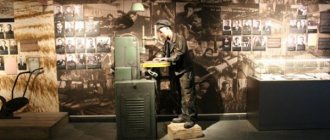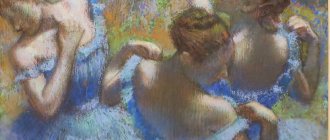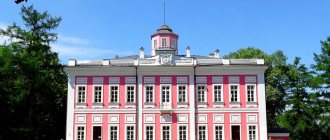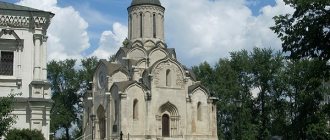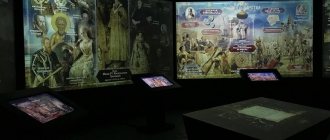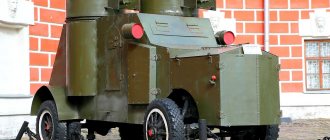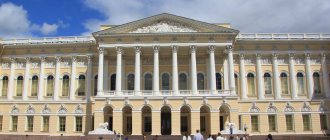Enlarge map
Museum address
Bolshaya Nikitskaya st., 2, Moscow
Operating mode
- Monday Closed
- Tuesday 10:00–18:00
- Wednesday 10:00–18:00
- Thursday 13:00–21:00
- Friday 10:00–18:00
- Saturday 10:00–18:00
- Sunday 10:00–18:00
Ticket price
adults - 300 rub. children under 7 years old - free students, pensioners, schoolchildren - 150 rubles
Official site
Phone number
+74956293948
The Zoological Museum of Moscow State University is one of the largest in Russia.
History of creation
Today, the zoological museum existing at Moscow State University is not only the largest in terms of the territory it occupies, but also the richest in terms of the volume of funds after a similar institution of a similar profile operating at the Russian Academy of Sciences. Truly unique specimens and rich scientific collections are collected here. The Zoological Museum of Moscow State University on Bolshaya Nikitskaya Street is one of the ten largest in the world.
In 1755, according to the decree of Elizabeth Petrovna, the Moscow Imperial University was founded. Today it is known as Moscow State University. The Zoological Museum was opened thirty-six years later. However, this does not prevent it from being considered one of the oldest Russian natural science centers.
Its history dates back to 1791. It was at this time that the Natural History Cabinet at Moscow State University was founded. A zoological museum was opened later on its base. Initially, the collection was replenished through private donations. The most significant was the collection from the Semiatichesky office and the P. Demidov museum. Very rare specimens of animals and plants, minerals, coins, etc. were collected here. Unfortunately, almost all museum exhibits of the Imperial University were destroyed during the fire of 1812.
Miraculously, only a few rare shells of mollusks and corals were preserved.
Aria about coelacanth
An important aspect of the exhibition consists of exhibits illustrating the history of the origin of modern groups of animals.
– Coelacanth is a rare exhibit. We have to admit that this is a mock-up. This is a representative of lobe-finned fish that were considered extinct and were related to the emergence of vertebrates on land. Their fins are structured in some ways like our hands. The coelacanth was first discovered in 1938, and today it seems that about 100 specimens are kept in all museums around the world. We have the only copy in our country, which is located at the Institute of Oceanology. And an exact cast was made especially for us,” notes the museum director.
Photo: m24.ru/Alexander Avilov
Branch
In the twenties, a zoological collection was separated from the partially restored office. It formed the basic basis of the museum of the same name. The latter was housed in Pashkov’s former house, which was reconstructed into an auditorium building for Moscow State University. The Zoological Museum was organized according to a systematic principle. This, according to the organizers, made it possible to illustrate as comprehensively as possible the entire natural evolution of animals.
In 1822, an inventory of all collections was published for the first time, which included more than a thousand items of vertebrate specimens and twenty thousand invertebrate animals.
Address
The exhibition complex is located at the address: Moscow, Bolshaya Nikitskaya street, building 6. It is not difficult to find. It is located directly in the center of the capital.
Is it difficult to reach by public transport? Not at all - having taken the metro to the Library named after. Lenin" or "Okhotny Ryad", you need to head to house No. 6 on Bolshaya Nikitskaya Street (this is the former Herzen Street). The location you are looking for is located nearby and can be reached in less than ten minutes.
Managers
From 1804 to 1832, the organization was headed by G. I. Fisher. He was an outstanding zoologist, a student of K. Linnaeus himself, who wrote the very first scientific works on the Russian fauna. In 1832, the first director of the Zoological Museum of Moscow State University developed a project according to which he proposed organizing the institution entrusted to him according to the model of classical French, English and German analogues. However, his proposal was not accepted.
From 1837 to 1858 The zoological museum was headed by K. F. Roulier. Being the founder of the Russian ecological school, he focused on the domestic fauna and its study. Roulier attached great importance not only to the collection of serial materials on modern animals, but also fossils. Thanks to this concept, by the end of the fifties of the nineteenth century, the museum had accumulated more than sixty-five thousand exhibits.
Professor A.P. Bogdanov, who led it from 1863 to 1896, played an invaluable role in the development of this institution. It was they who divided the existing funds, separated exhibition, scientific and educational ones, and systematized accounting work. In 1866, the exhibition of the Zoological Museum of Moscow State University was open for viewing, and by the end of the nineteenth century, according to statistics, up to eight thousand people visited it annually.
Moving to a new building
At the beginning of the twentieth century, a new building was built especially for the museum, which in those years was headed by Professor A. Tikhomirov. The project was made by academician Bykhovsky. The new building was located on the corner of Dolgorukovsky (formerly Nikitsky) lane and Bolshaya Nikitskaya street. It has remained in its original form to this day, without any structural changes.
In 1911, a new systematic exhibition was opened to the public in the upper hall. In the twenties of the last century, the building on Bolshaya Nikitskaya also housed work premises for employees of the Zoology Research Institute, and since 1930, some divisions of the Faculty of Biology of Moscow State University. The Zoological Museum was also included in its structure.
Dead single-celled
Museum director Mikhail Vladimirovich Kalyakin, Doctor of Biological Sciences, talks about the advantages of the museum:
– Today, few people understand the difference between the Zoological Museum and, say, the Paleontological or Darwin Museum. But I would like every visitor to understand that this museum is part of Moscow State University, that on its staff there are real scientists who study the diversity of biological species, or, to put it simply, study the diversity of animals. Our museum is open both to specialists in various fields of zoology and biology, and to ordinary people.
Photo: m24.ru/Alexander Avilov
Halls of the Zoological Museum of Moscow State University
Today, visitors are presented with more than ten thousand exhibits illustrating the enormous diversity of the animal world of our planet. In the spacious halls of the museum, the exhibitions are built systematically, according to evolutionary criteria and the international zoological classification. This allows visitors to easily navigate through the sections of the rich collection. Miniature life forms, for example single-celled organisms, are represented in the museum by dummies.
The hall on the first floor contains most of the exhibits - from insects and shells to higher beings. Presented in the form of original dioramas, the exhibitions give visitors the opportunity to see representatives of the animal world - reptiles, amphibians, mammals, birds, etc. in their natural habitat. One of the rooms displays deep-sea life forms, as well as ocean floor ecosystems.
Excursions offered
The museum regularly conducts excursions for children and adults - about 30 in total. There are sightseeing tours, which include inspection of exhibits in each hall of the museum, and thematic ones. The latter are deeper and dedicated to one particular exposure.
The duration of any excursion is 45 minutes. The number of people in the group is from 2 to 20. You can book and pay for the excursion online on the museum’s website, or you can contact the tour desk. Office opening hours: Tuesday-Saturday from 10:00 to 15:00 (Thursday from 13:00 to 18:00).
Excursions for children and adults are regularly held at the museum.
Top floor
The Zoological Museum of Moscow State University named after M.V. Lomonosov is a three-story building. Its halls are located on the first two. On the second floor there is the “Bone Hall”. It was given this name because it contains the skeletons of many animals belonging to various zoological orders. The upper hall today is completely dedicated to an exhibition telling about the huge variety of mammals and birds. Almost all the objects in this exhibition are stuffed animals, which were made by the best Russian taxidermists working at the end of the nineteenth and throughout the twentieth century. In both halls, exhibits are mainly placed in strict accordance with their systematic positions.
Visitor reviews
The fact that this place is truly very interesting is evidenced by numerous positive reviews from visitors. Here are some of them:
- “I’ve lived in Moscow for almost 50 years, but this was my first time visiting the zoo museum. And I was pleasantly surprised. Everything turned out to be very educational. I recommend visiting, it won’t be a waste of time” Alexander, 48 years old, Moscow;
- “I went to the exhibition on the advice of friends, and did not regret it at all. The exposition turned out to be simply unique. Allowed to take free photos” Anastasia, 45 years old, Reutov;
- “I brought my seven-year-old daughter to the Zoological Institute. To make the excursion more interesting, we hired a guide. The child received a lot of impressions, especially impressed by the exhibition of animal skeletons” Lydia, 36 years old, Balashikha;
- “We came to get acquainted with zoology with our three children (9, 7 and 5 years old), we left the car in the parking lot. The establishment pleased me with its excellent exhibits and cleanliness. The whole family had great fun, the children were delighted with the starfish, the she-wolf with her cubs, the squirrel and the big sea turtle.” Evgeniy and Svetlana, Yegoryevsk, Moscow region;
- “The zoo museum has an exhibition of sea mollusks, and my son is very interested in them. We can say that we came for this exhibition. Immediately on the spot we became interested in other exhibits and had a pleasant time. All the information turned out to be informative and interesting. The staff here is very well-mannered and polite. It turns out that on Sundays they hold special classes for schoolchildren, you should definitely attend these lectures.” Angelina, 36 years old, Moscow.
What excursions are held at the Zoological Museum, see the following video:
Interesting exhibitions
The symbol of the Moscow State University Zoological Museum is a small animal, the muskrat. It is he who is depicted on the emblem. There is so much interesting in the museum that it is impossible to see everything in one day. One of the most recent exhibits is the hydrothermal vent community. Compared to other sections of the museum, it looks very unusual. The main object of this exhibition is not a specific systematic group, but different animals that together make up a common ecosystem that is “immersed” in the ocean. This is the only earthly system of its kind, which directly owes its existence on a planetary scale to processes occurring in the bowels of the earth.
Opening hours, ticket prices
The Zoological Museum is open every day except Tuesdays. Visits are allowed from 11 a.m. to 6 p.m.
Every second Wednesday of the month the museum holds a sanitary day. The museum is closed on these days.
During the spring and autumn school holidays, weekends are cancelled.
When purchasing tickets, please note that the ticket office is open until 16:50. Every day from 14:00 to 14:15 technical break.
Ticket prices depend on the category of visitors:
- Adult ticket – 250 rubles.
- Any categories of students, full-time students and pensioners – 150 rubles. To purchase a ticket at a reduced price, you must present a document confirming your membership in a preferential category (certificate from an educational institution, student ID, pension certificate).
- The following categories of people can visit the museum for free:
- preschoolers;
- members of large families (parents, children);
- disabled people – groups I, II;
- WWII participants;
- residents of besieged Leningrad;
- museum staff.
- You can visit the museum for free on the third Thursday of every month. Excursions on these days are paid without benefits.
- When ordering an excursion, entrance tickets are included in the price. The cost of excursions depends on the category of visitors and the number of people:
- individual excursion for a group of up to 5 people – 1,700 rubles;
- sightseeing tour for preschoolers – 1200 rubles for a group of up to 15 people, 1500 rubles for 15-20 people;
- a thematic excursion for preschoolers – 1500 rubles for a group of up to 15 people, 1700 rubles for 15-20 people;
- sightseeing tour for a group of schoolchildren up to 20 people – 2100 rubles;
- a thematic excursion for a group of schoolchildren up to 20 people – 2400 rubles;
- sightseeing tour for a group of adults up to 20 people – 5100 rubles;
- a thematic excursion for a group of adults 1-12 people – 2900 rubles;
- mixed excursion for a group of adults and preschoolers (10+10) – 3200 rubles, adults and schoolchildren (10+10) – 3500 rubles.
Excursions can be booked in advance. This can be done from 11 a.m. to 5 p.m. It is allowed to exceed the number of tourists, but for a fee. For an additional fee, the tour can be conducted in English or German.
Exhibits
A small number of stuffed animals are mounted along the central line of the upper hall. There are also thematic displays dedicated to birds - “Hunting with Birds of Falcon”, “Bird Bazaar”, “Birds of the Moscow Region”.
The Zoological Museum of Moscow State University carries out serious work, studying and systematizing knowledge about animals. Of the ten million exhibits available, only eighty percent are on display. Among them there are also unique representatives of the fauna, for example, the heaviest goliath beetle, etc.
The largest and most interesting exhibits of the museum, due to their substantial size, are presented in the lobby. One of them is a stuffed elephant, which lived in the Moscow Zoo in the post-war years. The second exhibit is the skeleton of a rare woolly mammoth, the last species to live on the planet. It has an interesting feature - a trace of a serious fracture of the skull bone. In addition to biological exhibits, the Zoological Museum of Moscow State University has a good collection of paintings by animal artists.
Additional Information
The institution carries out active scientific work. Many famous scientists, including foreign ones, collaborate with the museum. He has a good library, which contains more than two hundred thousand volumes of literature and research related to biological topics. The museum organizes not only excursions for visitors of different ages, but also interactive classes for children from four to fifteen years old. Lessons are conducted according to the type of active communication. The museum constantly hosts themed children's parties: “Bird Day”, “Russian Muskrat”, etc. By the way, the last animal is, as already mentioned, a symbol of the Zoological Museum of Moscow State University.
On weekends there is a scientific terrarium here. The museum contains numerous living reptiles. Visitors are allowed to feed the chameleons, hold an agama, and the terrarium staff will talk about the habits of their charges in a fascinating manner. The cost of a ticket to visit the museum for adults is two hundred, and schoolchildren, students and pensioners need to pay fifty rubles.
Museum for children
The museum will also be interesting for children, starting from preschool age. For visitors aged 5-10 years, museum workers have developed special educational excursions. The children will be told about insects, animals and birds, about dinosaurs and about those animals that are most often found in fairy tales. Children over 10 years old can attend all other excursions on the same basis as adults.
In the exhibition halls you can have a fun children's birthday party (up to 10 people). Several holiday scenarios have been developed for different age groups. Children will enjoy fun competitions, active games, quizzes and quests.
If a child is interested in wildlife, he will enjoy studying in a group of young naturalists. Children from 12 years old are accepted there. 1-2 times a week they listen to lectures on zoology, and on weekends 1-2 times a month there are field trips - both in the Moscow region and throughout the Russian Federation.
